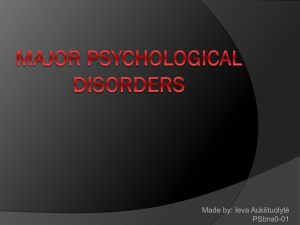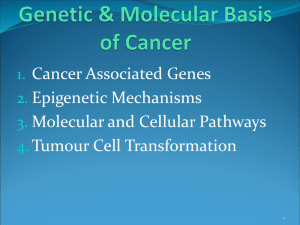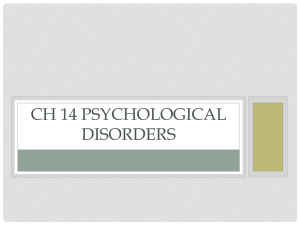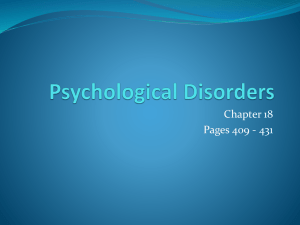Ch. 18: Psychological Disorders
advertisement
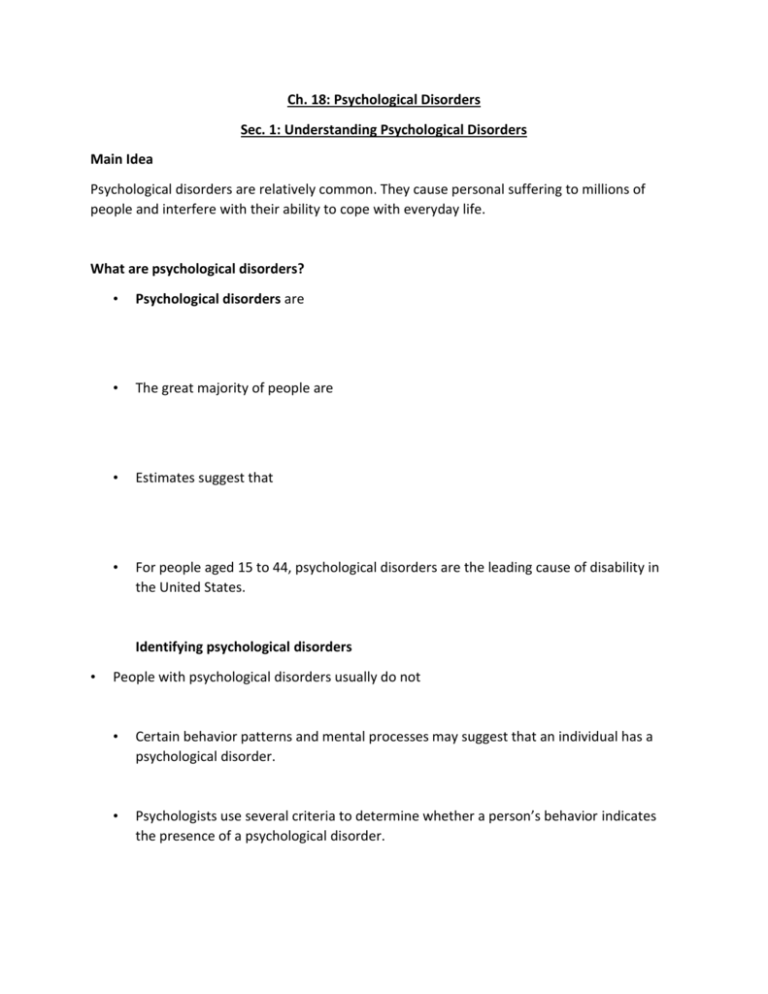
Ch. 18: Psychological Disorders Sec. 1: Understanding Psychological Disorders Main Idea Psychological disorders are relatively common. They cause personal suffering to millions of people and interfere with their ability to cope with everyday life. What are psychological disorders? • Psychological disorders are • The great majority of people are • Estimates suggest that • For people aged 15 to 44, psychological disorders are the leading cause of disability in the United States. Identifying psychological disorders • People with psychological disorders usually do not • Certain behavior patterns and mental processes may suggest that an individual has a psychological disorder. • Psychologists use several criteria to determine whether a person’s behavior indicates the presence of a psychological disorder. Typicality • • Normality is determined by the degree to which a behavior is average, or typical, of the majority of people. – Scientific and artistic geniuses are – People who are quite normal may have lifestyles that differ widely from the rest of the community. Additional measurements must be taken into account. Maladaptivity • Maladaptivity is • Behavior that causes misery and distress rather than happiness and fulfillment, or that is dangerous Emotional Discomfort • Depression and anxiety • Helplessness, hopelessness, worthlessness, guilt, extreme sadness, and withdrawal Socially Unacceptable Behavior • Cultural context of a behavior must be taken into account. • Culture-bound syndromes: Sec. 2: Anxiety and Mood Disorders Main Idea Anxiety disorders cause people to experience irrational or excessive fear. Mood disorders cause people to experience mood changes that are inappropriate to the situation. What is anxiety? • Anxiety refers to a generalized state of dread or uneasiness that occurs in response to a vague or imagined danger, as opposed to fear, which is a response to a real danger or threat. – • Characterized by • Nervousness • Inability to relax • Concern about losing control • Trembling • Sweating • Rapid heart rate • Shortness of breath • Increased blood pressure Everyone feels anxious at times, but constant anxiety can interfere with effective living. Types of anxiety disorders Phobic Disorder • Phobia: derives from the • Specific phobia is the most common of all anxiety disorders and refers to – • Most common include • Zoophobia: • Claustrophobia: • Acrophobia: • Arachnophobia: Social phobia is characterized by Panic Disorder and Agoraphobia • People with panic disorder have recurring and unexpected panic attacks, or relatively short periods of intense fear or discomfort characterized by shortness of breath, dizziness, rapid heart rate, trembling, choking, etc. • Agoraphobia: the fear of – Many people with agoraphobia develop panic attacks when in public. Generalized Anxiety Disorder • An excessive or unrealistic – Few people seek treatment because it does not differ, except in intensity and duration, from the normal worries of everyday life. Obsessive-Compulsive Disorder (OCD) • Obsessions are • Compulsions are • People are usually aware that the obsessions are unjustified, which distinguishes obsessions from delusions. Stress Disorders • Include post-traumatic stress disorder (PTSD) and acute stress disorder – Similar symptoms, – PTSD occurs after Explaining anxiety disorders Psychological Views • Psychoanalytic views are no longer widely accepted, but have affected the classification of psychological disorders. • Learning theorists believe • Cognitive theorists believe that Biological Views • Heredity • Studies of twins indicate that having a parent or sibling with a disorder increases the chance an individual will have a disorder. • Some psychologists believe that people who rapidly acquired strong fears of real dangers would be more likely to live and reproduce. • Interaction of Factors: some cases reflect the interaction of biological and psychological factors. Types of mood disorders • Most people have mood changes that reflect the normal ups and downs of life, but mood changes that are inappropriate to a situation can signal a mood disorder. • Two types: depression and bipolar disorder Major Depression • Feelings of • The DSM-IV contains a list of symptoms to help diagnose Bipolar Disorder • A cycle of • Period of mania, or Postpartum Depression • Some women suffer • Can harm both mother and child Explaining mood disorders • Psychological Views – The psychoanalytic view of depression – Learning theorists: – Cognitive theorists: • Attribution theory: people assign different types of explanations to events, which affect self-esteem and self-efficacy. • • • Beck suggests that people who are depressed have a negative view of themselves, their experiences, and their future. Biological Views – Mood disorders occur more – Two neurotransmitters in the brain—serotonin and noradrenaline—may partly explain the connection between genes and mood. Biological and Psychological Factors – A combination of factors is most likely at work. Current research in psychology Post-Traumatic Stress Disorder and Iraq War Veterans For those who survive the horrors of war, the trauma of combat may not be left behind on the battlefield. Some veterans report vivid flashbacks and nightmares. • A high incidence of PTSD has been reported among soldiers returning from war in Iraq and Afghanistan. • Researchers are seeking reasons • Younger veterans are • Those with • Currently veterans can receive five years of free health care for any mental disorder related to combat. • Because PTSD shows up long after the trauma, increased mental health services will be necessary. Sec. 3: Dissociative and Somatoform Disorders Main Idea Dissociative disorders cause people to lose their memory or identity. Somatoform disorders cause people to express psychological distress through physical symptoms. Dissociative disorders • Dissociation: • In some situations, • If dissociation Dissociative Amnesia • Characterized by a • It cannot be explained biologically. • The incidence of dissociative amnesia • Dissociative Fugue • Characterized by not only forgetting personal information and past events but also by suddenly relocating from home or work and taking on a new identity. • Individuals may appear healthy until the fugue ends, when they will not remember anything that happened during the fugue. Dissociative Identity Disorder • Involves the existence of two or more personalities within a single individual. The various personalities may or may not be aware of the other. Depersonalization Disorder • Depersonalization: • People describe Explaining dissociative disorders • Psychoanalytic theory suggests people • Learning theorists claim individuals • Cognitive and biological theorists have not offered a complete explanation of dissociative disorders. Somatoform disorders Somatization: the expression of psychological distress through physical symptoms. People with somatoform disorders have psychological problems (such as depression) but experience inexplicable physical symptoms (such as paralysis). Conversion disorder • Patients experience a change in • Patients often • A person’s unrealistic preoccupation • Patients may become absorbed Explaining somatoform disorders • Explanations are • Psychoanalytic theory suggests disorders occur when individuals repress emotions associated with forbidden urges and instead express them symbolically in physical symptoms. • Other psychologists have argued that people with conversion disorder “convert” psychological stress into actual medical problems. • Behavioral theorists have suggested that somatoform symptoms can serve as a reinforcer if they successfully allow a person to escape from anxiety. • There is some evidence that biological or genetic factors may play a role. Sec. 4: Schizophrenia Main Idea Schizophrenia is the most serious psychological disorder, causing thought disruption and a decreased ability to function normally. What is schizophrenia? • Schizophrenia: – Can be very disabling and can lead to • – First appears – Usually develops gradually, but can also appear suddenly Most striking symptoms are: – Hallucinations – Delusions – Thought disorders • Other symptoms include social withdrawal, impaired social skills, loss of normal emotional responses. • Occasionally, may go into a catatonic stupor: Types of schizophrenia Paranoid Schizophrenia • Delusions or frequent auditory hallucinations Disorganized Schizophrenia • Incoherent in their thought and speech and disorganized in their behavior; • Emotionless or Catatonic Schizophrenia • Activity may slow to a stupor • May hold unusual, uncomfortable body positions for long periods of time, even after their arms and legs swell and stiffen Explaining schizophrenia Psychological Views • Result of overwhelming • Fantasies become • Family environment may spur disease, but does not cause it. Biological Views • Studies try to link abnormal brain functioning and structure with specific symptoms. • Heredity, complications during pregnancy and birth, and birth during winter were all shown to affect rates of schizophrenia. Multifactorial Model • Biological and psychological • The model suggests that even severely dysfunctional environmental factors are not enough to lead to the disease. Personality disorders Main Idea Personality disorders are characterized by patterns of unchanging personality traits that disrupt people’s social lives and work lives. What are personality disorders? • Personality disorders: • An enduring pattern of inner experience and behavior that deviates markedly from the expectations of the culture of the individual who exhibits it • Usually show up • Psychological disorders are illnesses that an individual experiences as episodes. In contrast, personality disorders are enduring traits that are major components of the individual’s personality. Explaining personality disorders Both psychological and biological theories have been suggested to explain some of them. Psychological views • Psychoanalytic theory suggests • Learning theorists suggest • Cognitive theorists argue Biological views • Antisocial personality disorder • Some evidence suggests that antisocial people have less developed emotional centers in their brains. • Biological factor by itself is unlikely to cause the development of antisocial personality disorder.





